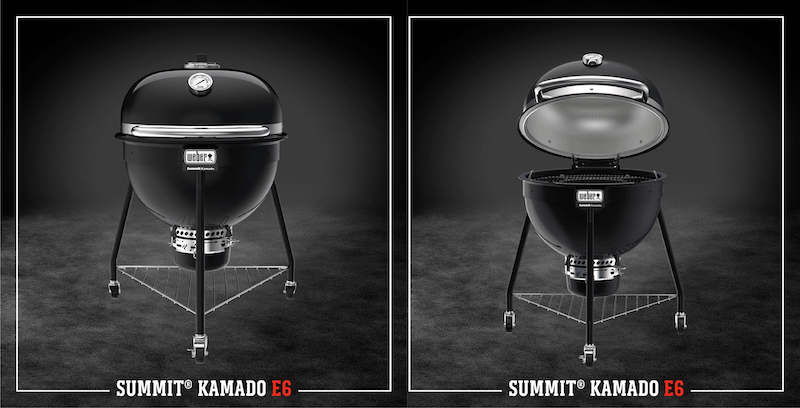Weber Summit Kamado - Pre-market assesment (the science of kamado cooking)

There has been some interesting moves in the BBQ market this year. A lot of them feel like people going through the motions or just trying to get some skin in the game of other grill types. Kamado Joe are making moves into both the kettle market (taking on Weber) and the pellet grill market (taking on Traeger).
But this quick write up is focussing on Weber’s upcoming new kamado grill.
A lot has been made about all these moves, but that said, at the current price point and designs, I can’t see any of them having too much of an effect on the market.
Weber’s new kamado grill - Summit E6
The new Weber Summit’s range are coming in towards the top end of the market - at £900 for standard version and then £1,800 for the top end version with the table. This isn’t Weber’s first outing in this market, the first generation Summit was very similar in construction, but didn’t seem to cause as much of a stir as the second generation kamado, this time around.
Anyway, enough of my speculation on the commercial prospects. The thing I have really come to write about is the science and the whole kamado angle.
1. What is a kamado?
Kamado style cooking comes from a long tradition of cooking in Japan, and technically, the portable or mobile kamado ovens were made with ceramic pots (the ceramics being a core part of the oven’s technique) - But I’m neither here for history lessons nor to get caught up on technical definitions or etymology. I have no issues with Weber calling their BBQ, which has no ceramic elements, a Kamado - after all, this is the term that has been so widely adopted and associated with a particular grilling style in the BBQ community that it makes sense to lean into that brand, as from a functional point of view there are similarities.
When Weber refers to their BBQ as a kamado, all it really means is its a similar shape and its more fuel efficient. That’s about it. It has a similar set up to a Kamado BBQ, it has the fire pit at the bottom, a deflector plate for indirect radiant cooking, two food grills and a large domed lid to aid the flow of convection cooking in the BBQ (the convection works the same way as I described in a WSM cooker with the water pan in here).
A big factor here, and a big differentiating factor that Weber are leaning into, is the fuel efficiency and how they achieve that. When people look at buying kamado grills, the fuel efficiency is a big factor. Because kamados can hold heat so well, it requires a lot less fuel than other grills (such as a kettle or Smokey Mountain). So let’s look at how they achieve their heat efficiency.
2. What makes the Weber Summit fuel efficient?
Weber achieve efficiency through insulation of the body of the grill. The entire grill body and lid is double skinned, that is, there are two sheets of metal with a layer of air between them. This is a common approach to insulation and can be seen in the construction of thermos flasks and double glazing windows, for example. This makes for a very effective way to retain heat inside the body of the grill, and the more heat that you can keep inside the grill, the lower you can keep the heat source (the fire), and the slower you will use up your fuel (coal).
3. What makes a traditional, ceramic kamado fuel efficient?
A traditional ceramic kamado grill, on the other hand, relies on thermal mass rather than insulation to retain heat. Its thick grill body, additional fire bowl and heat deflector are heavy ceramic stone. However, rather than having insulating properties, the stone has a much larger thermal mass. During cooking, the ceramics are able to absorb huge amounts of the heat energy that is slowly released back into the oven, which also helps to regulate the temperature and keep it more stable over long periods.
4. Insulation vs Thermal mass
Insulation basically controls the temperature in the BBQ by slowing the rate of energy loss out of the BBQ. Thermal mass in ceramic kamados controls the temperature by storing the heat energy in the ceramic parts in the body of the grill.
Both insulation and thermal mass have pros and cons, though:
-
Insulation allows for a much lighter build, so the Summit will be far easier to move about and transport - if portability is important factor of a grill for you, then this is a big difference.
-
Insulation allows for easy control of temperature, kamados are famously harder to bring a temperature down if you get it too hot - this is because the heat energy is stored in the thermal mass, so even if you reduce the heat source, there is a huge amount of heat energy stored in the thermal mass of the ceramics that takes a long time to change (which is the whole point - this is how it regulates the temperature in the grill)
-
Insulation on the other hand, only works whilst the grill is closed - if you lift the lid, all that heat energy that you have been so effectively retaining inside the grill escapes. You’d expect to see a bigger drop in temperature every time you open the summit compared to opening a ceramic kamado, as the energy doesn’t escape from the thermal mass easily.
-
Likewise, when bringing it back up to temperature its more likely to initially overshoot and then come back down with insulation, where as ceramics give you a much more stable temperature with less fluctuation.
5. Conclusion
The new Weber Summit is most likely going to be a great grill, given Weber’s pedigree and ability to produce high end BBQ equipment. The differences between heat regulation compared to a traditional kamado are negligible, but the on paper, the Summit probably has the edge.
That said, I don’t think its enough of an edge. At this price point, I can’t see many people picking the new Weber Summit over a traditional kamado unless they are already big fans of Weber. I think the Weber fans with money to spare will buy these, the KJ/BGE/etc fans will keep buying KJ/BGEs and those unsure but wanting something like this, I think will settle on the side of tradition - if only for the romantic nostalgia and history engrained with everything kamado cooking imbues.
6. Sidenote: Pros and Cons of heat efficiency
Sure, why wouldn’t anyone want heat & fuel efficiency? Seems crazy to suggest there are downsides to this, but there are, and probably worth mentioning here, as these disadvantages apply equally to the new Weber Summit as they do traditional kamado.
Ok, so the advantages are obvious - you can go for longer without having to re-fuel the grill, and generally you will get through less charcoal and therefore save money. All good things.
However, the downside is this heat efficiency can make smoking meat more difficult, and its why you won’t get as good a smoke flavour on a kamado as you would a Weber Smokey Mountain (or kettle, or offset etc). An efficient grill has two side effects:
-
As the grill is more efficient, you will be running at a lower heat - to do this, you reduce the airflow through the unit (keep the vents relatively small) - this keeps the fire burning low, making it more fuel efficient, and also makes the inside of the grill more humid (which also makes it more efficient at cooking!). But this also means there isn’t a constant flow of smoke running past the meat at the same rate.
-
Also, as the fire is likely burning at a lower rate, it makes it harder for wood to properly burn to the point of creating smoke - it will more likely have a low smoulder which is not the ideal for creating smoke for smoking. The Weber Smokey Mountain (or bullet smokers in general) are great at smoking because they are so fuel inefficient - the fires burn hotter, creating more smoke combined with better airflow.
A quick google will also reveal that a not uncommon complaint cooking on a kamado is that they don’t achieve the famous smoke ring on their cooks - when this happens, this is also down to the efficiency (lack of airflow and increased humidity) - thats of course not to say you can’t get incredible smoke rings on a traditional kamado, just that sometimes they have been known to go missing!
